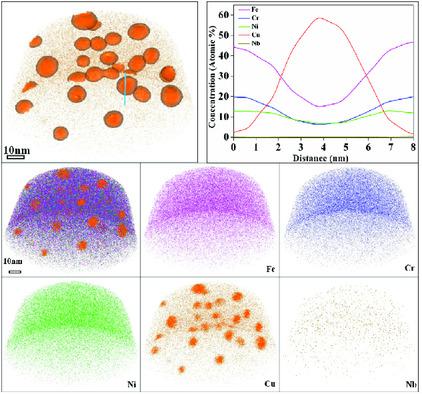当前位置:
X-MOL 学术
›
Steel Res. Int.
›
论文详情
Our official English website, www.x-mol.net, welcomes your feedback! (Note: you will need to create a separate account there.)
Multiphase Strengthening of Nanosized Precipitates in a Cost‐Effective Austenitic Heat‐Resistant Steel
Steel Research International ( IF 2.2 ) Pub Date : 2020-05-04 , DOI: 10.1002/srin.202000122 JiKang Du 1 , YiFan Zhang 1 , ShaoLin Wang 1 , ShuLiang Zhou 1 , PingPing Liu 1 , XiShan Xie 1 , WenTong Geng 1 , Qian Zhan 1
Steel Research International ( IF 2.2 ) Pub Date : 2020-05-04 , DOI: 10.1002/srin.202000122 JiKang Du 1 , YiFan Zhang 1 , ShaoLin Wang 1 , ShuLiang Zhou 1 , PingPing Liu 1 , XiShan Xie 1 , WenTong Geng 1 , Qian Zhan 1
Affiliation

|
A newly developed austenitic heat‐resistant steel Fe–22Cr–15Ni (SP2215) is aged at 700 °C for different times, which presents good mechanical properties. The stress rupture strength can be maintained at 78 MPa by extrapolating to 105 h at 700 °C. Transmission electron microscopy (TEM) analysis reveals the multiphase composites strengthening mechanism. Three types of precipitates, the coherent Cu‐rich particles, Nb‐rich carbonitrides and NbCrN phase, are found in the austenitic matrix. The fine Cu‐rich particles are the first to precipitate, most densely and homogeneously distributed, as is illustrated by atom probe tomography (APT). It is concluded that it is the multiphase nanoprecipitate strengthening and the high thermal stability of the precipitates that render the excellent mechanical properties at high temperature. With the significant advantages of high strength at 700 °C and cost‐effective, the novel austenitic heat‐resistant steel SP2215 is recommended to be a promising material for high‐efficiency superheaters/reheaters of ultra‐supercritical unit boiler at steam temperature from 620 to 650 °C.
中文翻译:

具有成本效益的奥氏体耐热钢的纳米级析出物的多相强化
新开发的奥氏体耐热钢Fe-22Cr-15Ni(SP2215)在700°C下进行了不同的时效处理,具有良好的机械性能。通过在700°C下外推至105 h,可以将应力断裂强度保持在78 MPa。透射电子显微镜(TEM)分析揭示了多相复合材料的强化机理。在奥氏体基体中发现了三种类型的沉淀物:相干的富铜颗粒,富铌的碳氮化物和NbCrN相。如原子探针层析成像(APT)所示,富含铜的细颗粒是最先析出的,最致密且均匀分布的颗粒。结论是,多相纳米沉淀强化和沉淀物的高热稳定性使高温下具有优异的机械性能。
更新日期:2020-05-04
中文翻译:

具有成本效益的奥氏体耐热钢的纳米级析出物的多相强化
新开发的奥氏体耐热钢Fe-22Cr-15Ni(SP2215)在700°C下进行了不同的时效处理,具有良好的机械性能。通过在700°C下外推至105 h,可以将应力断裂强度保持在78 MPa。透射电子显微镜(TEM)分析揭示了多相复合材料的强化机理。在奥氏体基体中发现了三种类型的沉淀物:相干的富铜颗粒,富铌的碳氮化物和NbCrN相。如原子探针层析成像(APT)所示,富含铜的细颗粒是最先析出的,最致密且均匀分布的颗粒。结论是,多相纳米沉淀强化和沉淀物的高热稳定性使高温下具有优异的机械性能。


























 京公网安备 11010802027423号
京公网安备 11010802027423号